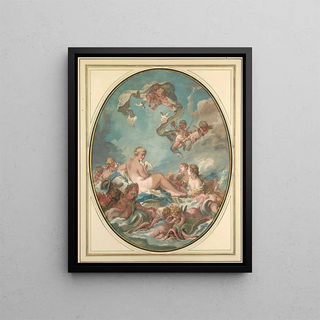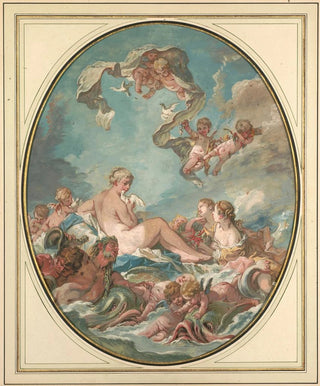Art print La naissance et le triomphe de Vénus - François Boucher | Art print


View from behind

Frame (optional)
Reproduction La naissance et le triomphe de Vénus - François Boucher – Captivating introduction
The painting "La naissance et le triomphe de Vénus" by François Boucher is a true ode to beauty and mythology. This iconic artwork, which immerses the viewer in a universe of sensuality and refinement, depicts the goddess Vénus emerging from the waves, surrounded by symbols of love and beauty. The delicacy of the lines and the harmony of colors invite deep contemplation, revealing the subtleties of rococo art. In this art print, the very essence of the original work is captured, allowing everyone to immerse themselves in this mythological scene where the divine meets the human.
Style and uniqueness of the work
François Boucher's style is inseparable from his era, the 18th century, when rococo art flourished in all its splendor. "La naissance et le triomphe de Vénus" stands out for its bold use of color and light, creating an effect of movement and vitality. The graceful curves of the figures, the flowing drapery, and natural elements such as shells and flowers demonstrate exceptional technical mastery. Boucher plays with contrasts, between shadow and light, to emphasize the beauty and sensuality of his characters. This work, with its lyrical character and evocation of life's pleasures, perfectly embodies the spirit of a time when art was synonymous with luxury and elegance.
The artist and his influence
François Boucher, born in 1703, is one of the most emblematic artists of his time. A student of François Le Moyne, he established himself as the painter of the court of Louis XV, becoming the favorite of the Marquise de Pompadour. His style, characterized by lightness and sensuality, profoundly influenced European art. Boucher was able to combine classical tradition with a more intimate and personal vision, paving the way for future artistic movements. His works, often inspired by mythology and literature, continue to inspire contemporary artists. "La naissance et le triomphe de V

Matte finish

View from behind

Frame (optional)
Reproduction La naissance et le triomphe de Vénus - François Boucher – Captivating introduction
The painting "La naissance et le triomphe de Vénus" by François Boucher is a true ode to beauty and mythology. This iconic artwork, which immerses the viewer in a universe of sensuality and refinement, depicts the goddess Vénus emerging from the waves, surrounded by symbols of love and beauty. The delicacy of the lines and the harmony of colors invite deep contemplation, revealing the subtleties of rococo art. In this art print, the very essence of the original work is captured, allowing everyone to immerse themselves in this mythological scene where the divine meets the human.
Style and uniqueness of the work
François Boucher's style is inseparable from his era, the 18th century, when rococo art flourished in all its splendor. "La naissance et le triomphe de Vénus" stands out for its bold use of color and light, creating an effect of movement and vitality. The graceful curves of the figures, the flowing drapery, and natural elements such as shells and flowers demonstrate exceptional technical mastery. Boucher plays with contrasts, between shadow and light, to emphasize the beauty and sensuality of his characters. This work, with its lyrical character and evocation of life's pleasures, perfectly embodies the spirit of a time when art was synonymous with luxury and elegance.
The artist and his influence
François Boucher, born in 1703, is one of the most emblematic artists of his time. A student of François Le Moyne, he established himself as the painter of the court of Louis XV, becoming the favorite of the Marquise de Pompadour. His style, characterized by lightness and sensuality, profoundly influenced European art. Boucher was able to combine classical tradition with a more intimate and personal vision, paving the way for future artistic movements. His works, often inspired by mythology and literature, continue to inspire contemporary artists. "La naissance et le triomphe de V
12,34 €






